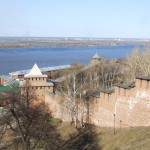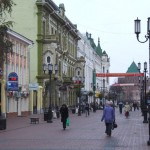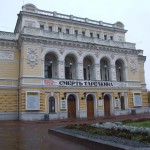Nizhny Novgorod
Nizhniy Novgorod (in colloquial speech often Nizhniy) — is the administrative center of Nizhniy Novgorod Oblast, the center and largest city of Privolzhskiy Federal District. It is located in the center of the East European Plain at the confluence spot of the Oka and Volga Rivers. The Oka River divides the city into two sections – the upper city, on the Dyatlovye Mountains, and the lower city, on its left flat bank. From 1932 till 1990, the city bore the name of Gorky (in honour of the writer Maxim Gorky).
Nizhniy Novgorod is the fifth largest city in Russia with the population of 1.255.159 people; it is an important economic, transportation and cultural center of the country. The city is the center of Nizhniy Novgorod agglomeration, populated by over 2.08 million people; it is the fourth largest in the country and second largest in Middle Povolzhye.
Nizhniy Novgorod is located 400 kilometers east of Moscow, and the transportation corridor between these two cities is singled out as a conurbation Moscow—Nizhniy Novgorod.
It is known as a major center of ship-building, aircraft and machine building industries and information technologies. Between 1959 and 1991, the city was closed to foreign citizens’ visitations, but at present it is the biggest center of riverboat cruise tourism in Russia and a venue for numerous international exhibitions in different fields on the basis of the Nizhniy Novgorod Fare.
In 1929–1932, it became the center of the Nizhniy Novgorod Region. From October 7 of 1932, the city bore the name of writer A. M. Gorky. On October 22 of 1990, according to the referendum’s decision, by the decree of the Presidium of the Supreme Council of RSFSR, the city recovered its historical name.
The general area of Nizhniy Novgorod is 46.000 hectares. Its population with satellite cities, as of January 1 of 2010, is 1.278.800 people.
Nizhniy Novgorod region and its Oblast center is a territory with predominating ethnic Russian population, which numbered up to 95% of all residents according to the last census. Nevertheless, over 100 different nationalities live in Nizhniy Novgorod. At the present moment, 28 ethnic cultural societies are officially registered in the city. The official and widely spoken language is Russian.
The climate is moderately continental. The mean temperature of January is around -12C (10F), July – 18C (64F). The amount of annual precipitation is 500 mm.
Nizhniy Novgorod is the capital of Privolzhsky Federal District, center of Nizhniy Novgorod region and acknowledged capital of Volgo-Viatsky economic zone.
At 137 major and medium-sized enterprises of 14 main sectors of economy around 179 thousand people are employed (41% of all working population in the city).
The industrial section produces between 50 and 60% of gross city product, which is close to 40% of the total industrial output of Nizhniy Novgorod Oblast.
The most developed sectors are machine-building and metal-working industries, food industry, iron and non-ferrous industries, healthcare, consumer goods production, wood-processing industry, mechanical engineering and metal-working industry (close to 69% in the total output of the city’s manufacturing).
The largest companies are: JSC «GAS», JSC «Nizhniy Novgorod Aircraft Building Plant «SOKOL», JSC « Nizhniy Novgorod Machine Building Plant», JSC «Plant «Krasnoye Sormovo», JSC «Nizhfarm» and so forth.
Nizhniy Novgorod has the following twin-cities: Tampere (Finland), Linz (Austria), Philadelphia (USA), Jinan (China), Essen (Germany), Kharkov (Ukraine), Matanzasс (Cuba), Suwon (South Korea), Novi Sad (Serbia), Minsk (Belorussia). Its partner cities are: Bologna (Italy), Brno (Czech Republic), Leipzig (Germany).
A number of unique monuments of history, architecture and culture are preserved in the city, which gave the ground to UNESCO to include Nizhniy Novgorod in the list of 100 cities of the world historic and cultural value.
The history of the city of Nizhniy Novgorod begins in 12221. Nizhny Novgorod was founded by Prince Yuri (George) Vsevolodovich upon the confluence of the two great Russian rivers, Volga and Oka, in 1221 to defend the Russian frontiers from the Mordvins, Maris and Tatars.
The City got its name “Nizhny” because of its location on the “lower” lands in comparison with Novgorod Velikiy (the Great) or with the so called “old town” that was situated four versts up the Oka, the record of which could be found in literature till the beginning of the 17th century.
The first wood-ground fortress had an extremely favorable military and strategic position – a mountain rising above the confluence of the Volga and the Oka, which was perfectly protected by a deep moat from one side and the steep crumble cliffs of the Volga river bank from the other side. During the first years there were two white-stone cathedrals built in the Kremlin – it testified to the fact that the town claimed to a particular role in the lands of Vladimir-Suzdal, but the Mongol-Tatars invasion did allow it to happen.
There is not much information about Nizhny Novgorod of the 13th century. It is known that the city revived very quickly after the devastation. For a short period of time, there was established a “veche republic,” such as in Novgorod the Great.
The location of the city determined its future. After the Mongol-Tatar yoke Nizhny Novgorod was frequently mentioned in Russian chronicles; it became a strong political and economic centre of North-Eastern Russia remaining at the same time a spiritual pillar of the Orthodoxy in the Volga region. At that time it often became a conflict object in the struggle for the influence zones between the gaining force Moscow and Tver. There was a time, when Nizhny Novgorod was the capital of an independent Grand Duchy, which existed for more than half a century (1341-1392) and was not inferior to Moscow and Tver in its striving for domineering Russia. Seventeen times in its history the city was attacked by enemies, not once it was razed to the ground, but it revived again and again.
Since the end of the 15th century, Nizhny Novgorod was an unfailing stronghold of Moscow in fighting for the Great River Way. At this time, a new stone-walled Kremlin was erected, later it was recognized as an outstanding construction of the Russian fortification art. In the summer of 1509, a foreign architect Peter Fryazin arrived and “on September the 1st, he founded Novagrad Nizhniy and made a stone wall with the Dmitrovskaya Strelnitsa.”
The analysis of the architecture and the construction peculiarities of the Nizhny Novgorod Kremlin allowed its restorer S. Agafonov to come to the conclusion that the fortress had been made by Russian workmen. The total perimeter of the Kremlin walls contains 13 towers (Dmitrievskaya, Porokhovaya, Georgievskaya, Borisoglebskaya, Zachatievskaya (the latter two are partly destroyed), Belaya, Chasovaya, Ivanovskaya, Severnaya, Tainitskaya, Koromyslova, Nikolskaya, Kladovaya), there was a detached strelnitsa (a special tower for shooting) which was connected with the Dmitrievsky gate by a stone arch-bridge, built across the 30-meter deep ditch, which has not survived till our days.
In 1612, from the walls of the Kremlin the volunteer corps leading by Kozma Minin and Dmitry Pozharsky took the field to fight the Polish-Lithuanian invaders. History still keeps the patriotic appeal of Kozma Minin to his fellow countrymen: “Oh, Brothers and Friends, all Folk of Nizhny! What should we do, when Moscow state is in great devastation? Let us call all brave men of Nizhny and true noblemen of the Smolensk City, who are not far from us now, in Arzamas region.” The citizens of Nizhny Novgorod supported the appeal with a single heart. The self-sacrifice and the feat of arms of the Nizhny Novgorod levies liberated Russia from the foreign interventionists.
After the Smuta (Great Ruin), the Volga Region had the opportunity to develop agriculture, industry, trade and culture. At that time the Nizhny Novgorod land determined the level of commercial and industrial development of the country. The biggest in the country Makariev Fair was held there. The Old Belief movement started to form, leader-ideologists (Avvakum Petrov, Stefan Vonifatiev, Pavel Kolomenskiy) and irreconcilable adversaries of which (patriarch Nikon, Metropolitan Riazanski and Muromski Illarion) were citizens of Nizhny Novgorod. In 1672 the Nizhny Novgorod Metropolia was set up.
After Kazan and Astrakhan were conquered (in 1552) by Ivan the Terrible, Nizhny Novgorod became the center of the most significant trade route between the Russian State and the West. In the XVII century, Nizhny Novgorod was the center of mass formation of boat caravans, where hundreds of workers were being hired. Salt, fish and oriental goods brought by the ships arriving from Astrakhan were transferred to smaller boats with shallow draft going up to the Upper Volga and Oka. At that time, Nizhny Novgorod became the center of shipbuilding. Crafts were very well developed in the city: in 1662, its citizens mastered 119 craft professions.
On the 28th of May, 1722, during the Persian wars Peter the Great arrived to Nizhny Novgorod. On the 30th of May he celebrated here his fiftieth birthday.
In the XVIII century, Nizhny Novgorod rose as an administrative center. Since 1714, it became the Governor’s seat, from 1779 till 1796 – the center of Nizhny Novgorod Vicegerency, which included provinces Viatskaya, Kostromskaya, Penzenskaya and Alatirskaya. The transformation of Nizhny Novgorod into the capital of a big Russian region favored the development of education, industry, trade, medicine, culture, sciences and town planning. At that time, a private hospital and pharmacy were opened, public private theaters began to work (the Drama Theatre, the oldest theater in Nizhny Novgorod, was founded in 1798 by Prince Shekhovskoy). In 1786, a four-class secular principal school was opened in Nizhny Novgorod. In 1792, a provincial printing-house was set up.
On the boundary of XVIII and XIX centuries, Nizhny Novgorod developed its cultural and scientific life. The genius inventor Ivan Kulibin lived and worked there. Nizhny Novgorod is proud of its outstanding citizens such as mathematician N.I. Lobatchevsky, scientist Damaskin, prominent teacher I.I. Kugelev, historian N. Ilyinsky, writer and traveler V. Baranchtchikov and others.
At the beginning of the XIX century, the citizens of Nizhny Novgorod took an active part in the Patriotic War. The local volunteer corps took part in the European march of Russian troops until the full victory over Napoleon and was disbanded only towards the end of 1815.
Many of the Decembrists were connected with Nizhny Novgorod: M. P. Bestuzhev-Rumin, Alexander and Nikolas Kryukov, S. P. Trubetskoy, Annenkov, N. V. Sheremetiev, V. I. Belavin, Ph. P. Shakhovskoy, A. N. Muravyov. The first one who expressed the utopian ideas of the Decembrist movement was also a citizen of Nizhny Novgorod – a musicologist and musician Ulybyshev.
In 1816, the recently built Fair complex in Makariev burned down. The All-Russia Trade Fair was transferred to the confluence of the Oka and Volga on the outskirts of Nizhny Novgorod. The Fair completely changed the appearance and lifestyle of the city.
Under the leadership and according to the projects of A. A. Betankur the original ensemble of the Fair was restored.
That largely contributed to the trade significance of the city and made it the third largest city of Russia.
The fair existed for over a century and played a great role not only in the history of Russian trade and establishment of the Russian market, but it was one of the largest fairs in the world.
In the 1830-1840s, the most significant architecture changes in the city took place.
Numerous public buildings and private trade houses of that time remain the main architectural background of the historical built-up of the city that has artistic value.
On September 2-3 of 1833, A. S. Pushkin visited Nizhny Novgorod on his way to Orenburg region, where he planned to research the subject of the peasant uprising under Y. Pugachev. He visited the Kremlin twice, crossed the trading Rozhdestvenskaya Street from one end to another, strolled on the territory of the famous Makariev Fair. The poet expressed his impressions after visiting the latter in one of the chapters of his “Eugene Onegin.”
In the middle of the 19th century, the centers of cultural activity in the city traditionally were in the houses of its following outstanding figures: V. I. Dahl, A. D. Ulybyshev, A. S. Gatsisky, V. G. Korolenko, F. I. Shalyapin and others, who were not born in Nizhny Novgorod, but were known for their work there. The city was always famous for its musical preferences, and a musical college that was established in 1870 was one of the first ones in the Russian province. The first provincial art exhibition was held in Nizhny Novgorod in 1886. Moreover, the founding fathers of the Russian art and publicist photography A. O. Karelin and M. P. Dmitriev lived and worked in Nizhny Novgorod.
The preparation and organization of the All-Russia Fair of art and industry in Nizhny in 1896 gave an important impetus to further development of the Nizhny Novgorod culture: the building of the city theatre was erected on Bolshaya Pokrovskaya Street.
In the Dmitriev tower of the Kremlin, historical and art expositions were opened. Soon they became the Modern Nizhny Novgorod Museum of Art and the Museum of History and Architecture.
The town-planning reconstruction of Nizhny Novgorod timed for the Fair’s opening, and the arrival of many prominent architects of Russia – L. Benua, A. Pomerantsev, I. Petrov-Ropet; engineers V. Shuhov, V. Kossov, stirred up the architectural art life in the city. A significant number of valuable monuments appeared in the city at the end of the XIX century.
In 1883 a Russian merchant N. A. Bugrov offered to the authorities to build up a special house for poor widows in front of the Krestovozdvizhensky monastery. Its project was designed by architect N. A. Fredlikh.
In 1897 the Duma (City Council) decided to build an administrative building on the Blagoveschenskaya square (Minin square).
In the general system of architecture, the fronts were decorated in the “Ancient Russia” style. In 1903-1904, under the oversight of architect N. M. Veshnyakov reconstruction of the interiors was carried out. Speaking about the period of the beginning of the XXth century, the interiors of the building remain most valuable as an object of art. In its forms, the building unites the architecture of the Kremlin with the various styles of houses of the adjoining districts of the city.
One of the brightest examples of constructions in Neo-Russian style is the building of the State Bank built according to the project of Vladimir Aleksandrovich Pokrovsky in 1913. As a whole, the architecture of the building has no precedents in the history of Russian architecture and is to be considered as a product of artistic fantasy of the project’s author. Semicircular towers, a projection at the north facade are associated with a defense construction, like a fortress or a castle, and the main volume of the building – with spacious boyars’ chambers. The unique interior paintings are made by P. P. Pashkov and N. P. Pashkov.
Since the beginning of the 1930s, the city was named after a proletarian writer A. M. Gorky. A stage of the active industrial growth of the city began after the revolution.
The Gorky Automobile Plant was built in 17 months and started operating on January, 1 of 1932. Trucks GAZ-AA, passenger cars GAZ-A, and M-1 flooded the roads of the country; and after the Great Patriotic War (World War II) there came GAZ-51, GAZ-63, GAZ-66, “Pobeda”, and “Volga”.
Almost simultaneously with the construction of the Automobile plant in Gorky, the construction of other industrial enterprises, such as the Plant of cutter machines, was commenced.
After the Civil war, the Sormovsky Plant, which was founded in 1849 as a ship building enterprise, significantly increased its production. Beyond steam locomotives, wagons the workers of Sormovo began to produce river boats and cruise ships, powerful diesel engines. In the 1950s, the constructors of Sormovo headed by R. E. Alekseyev made totally new types of river and sea vessels – “Raketa” and “Meteor”.
Materials taken from the web source: http://www.admgor.nnov.ru






